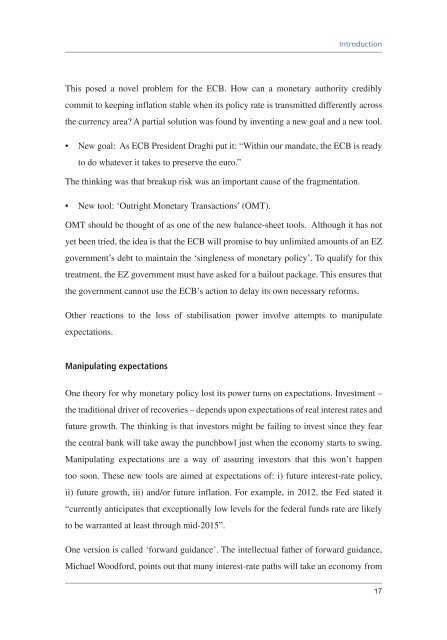You also want an ePaper? Increase the reach of your titles
YUMPU automatically turns print PDFs into web optimized ePapers that Google loves.
IntroductionThis posed a novel problem for the ECB. How can a monetary authority crediblycommit to keeping <strong>inflation</strong> stable when its policy rate is transmitted differently acrossthe currency area? A partial solution was found by inventing a new goal and a new tool.• New goal: As ECB President Draghi put it: “Within our mandate, the ECB is readyto do whatever it takes to preserve the euro.”The thinking was that breakup risk was an important cause of the fragmentation.• New tool: ‘Outright Monetary Transactions’ (OMT).OMT should be thought of as one of the new balance-sheet tools. Although it has notyet been tried, the idea is that the ECB will promise to buy unlimited amounts of an EZgovernment’s debt to maintain the ‘singleness of monetary policy’. To qualify for thistreatment, the EZ government must have asked for a bailout package. This ensures thatthe government cannot use the ECB’s action to delay its own necessary reforms.Other reactions to the loss of stabilisation power involve attempts to manipulateexpectations.Manipulating expectationsOne theory for why monetary policy lost its power turns on expectations. Investment –the traditional driver of recoveries – depends upon expectations of real interest rates andfuture growth. The thinking is that investors might be failing to invest since they fearthe central bank will take away the punchbowl just when the economy starts to swing.Manipulating expectations are a way of assuring investors that this won’t happentoo soon. These new tools are aimed at expectations of: i) future interest-rate policy,ii) future growth, iii) and/or future <strong>inflation</strong>. For example, in 2012, the Fed stated it“currently anticipates that exceptionally low levels for the federal funds rate are likelyto be warranted at least through mid-2015”.One version is called ‘forward guidance’. The intellectual father of forward guidance,Michael Woodford, points out that many interest-rate paths will take an economy from17



